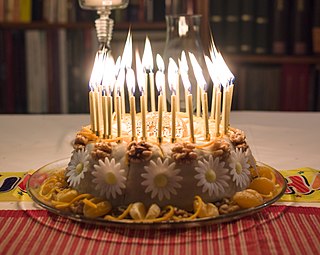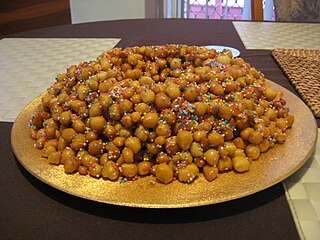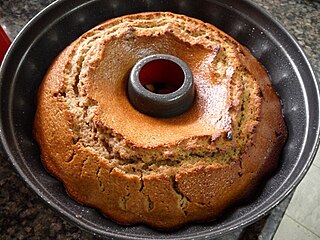Honey cake may refer to:
Honey cake may refer to:

Cake is a flour confection made from flour, sugar, and other ingredients and is usually baked. In their oldest forms, cakes were modifications of bread, but cakes now cover a wide range of preparations that can be simple or elaborate and which share features with desserts such as pastries, meringues, custards, and pies.
Buzzard is the common name of several species of birds of prey.

A wedding cake is the traditional cake served at wedding receptions following dinner. In some parts of England, the wedding cake is served at a wedding breakfast; the 'wedding breakfast' does not mean the meal will be held in the morning, but at a time following the ceremony on the same day. In modern Western culture, the cake is usually on display and served to guests at the reception. Traditionally, wedding cakes were made to bring good luck to all guests and the couple. Nowadays, however, they are more of a centerpiece to the wedding and are not always even served to the guests. Some cakes are built with only a single edible tier for the bride and groom to share, but this is rare since the cost difference between fake and real tiers is minimal.

A birthday cake is a cake eaten as part of a birthday celebration. While there is no standard for birthday cakes, they are typically highly decorated layer cakes covered in frosting, often featuring birthday wishes and the celebrant's name. In many cultures, it is also customary to serve the birthday cake with small lit candles on top, especially in the case of a child's birthday. Variations include cupcakes, cake pops, pastries, and tarts. In more recent years in North America, it has become a common flavour for confectionery including ice cream, PopTarts, various cereal varieties among others. The flavour is usually vanilla with sweeter hints to imply sprinkles.

Wet and messy fetishism (WAM), also known as sploshing, is a form of sexual fetishism whereby a person becomes aroused when copious amounts of a substance are applied to the naked skin, face, or to clothing. Several dozen websites are dedicated to WAM.

Funnel cake is a regional sweet food popular in North America, found mainly at carnivals and amusement parks. It is made by deep-frying batter.

Gingerbread refers to a broad category of baked goods, typically flavored with ginger, cloves, nutmeg, and cinnamon and sweetened with honey, sugar, or molasses. Gingerbread foods vary, ranging from a moist loaf cake to forms nearly as crisp as a ginger snap.

Nian gao, sometimes translated as year cake or New Year cake or Chinese New Year's cake, is a food prepared from glutinous rice flour and consumed in Chinese cuisine. It is also simply known as "rice cake". While it can be eaten all year round, traditionally it is most popular during the Chinese New Year. It is considered good luck to eat nian gao during this time of the year because nian gao (年糕) is a homonym for "higher year" or "grow every year" (年高), which means "a more prosperous year". The character 年 is literally translated as "year", and the character 糕 (gāo) is literally translated as "cake" and is identical in sound to the character 高, meaning "tall" or "high". In Mandarin, Nian gao (年糕) also is an exact homonym of "sticky cake" (黏糕/粘糕), the character 黏/粘 (nián) meaning "sticky".

Parkin is a gingerbread cake traditionally made with oatmeal and black treacle, which originated in Northern England. Often associated with Yorkshire, it is widespread and popular elsewhere, notably in Lancashire. Parkin is baked to a hard cake but with resting becomes moist and even sometimes sticky. There are regional differences, for example in Hull and East Yorkshire, it has a drier, more biscuit-like texture than in other areas whereas in Lancashire it is generally made with golden syrup rather than the treacle used elsewhere. Parkin is traditionally eaten on Guy Fawkes Night, 5 November, and when celebrating 'Yorkshire Day' on 1 August. But is also enjoyed throughout the winter months. It is baked commercially throughout Yorkshire, but is mainly a domestic product in other areas.
Honeypot may refer to:

Tiropita or tyropita is a Greek pastry made with layers of buttered phyllo and filled with a cheese-egg mixture. It is served either in an individual-size free-form wrapped shape, or as a larger pie that is portioned.

Struffoli, also known as Honey Balls, is a Neapolitan dish made of deep fried balls of sweet dough. The dough is used in many Italian sweet treats such as chiacchiere. For struffoli, the dough is formed in to balls about the size of marbles. Crunchy on the outside and light inside, struffoli are mixed with honey and other sweet ingredients and formed into mounds or rings. There are many different ways to flavour them, but the traditional way is to mix them in honey with diavulilli, cinnamon, and bits of orange rind. Naming varies by region: in Calabria they are also known as scalilli, and in Abruzzo cicerchiata. They are often served at Christmas and are sometimes served warm.

Marry girl cake or dowry cake is a traditional Chinese cake that was once a ceremonial cake used as a wedding gift in the traditional Chinese wedding ceremony, hence the name. Today, this cake is known more as a classic Chinese pastry rather than a wedding gift because it has lost most of its original significance due to cultural change. It can be found in Hong Kong and in some Chinatowns overseas.

Lekach is a honey-sweetened cake made by Jews, especially for the Jewish holiday of Rosh Hashanah. Known in Hebrew as ugat dvash, the word lekach is Yiddish. Lekach is one of the symbolically significant foods traditionally eaten by Ashkenazi Jews at Rosh Hashanah in hopes of ensuring a sweet New Year.

Gyeongdan (경단) or Korean rice ball cake is a type of tteok made of glutinous rice or other glutinous cereal flours. When the cereal other than rice is used, its name is usually specified, making compound nouns such as susugyeongdan. The name chapssalgyeongdan may also be used, but chapssal can be, and usually is, omitted.

Sesame seed candy is a confection of sesame seeds and sugar or honey pressed into a bar or ball. It is popular from the Middle East through South Asia to East Asia. The texture may vary from chewy to crisp. It may also be called sesame (seed)candy/bar/crunch; sesame seed cake may refer to the confection or to a leavened cake or cookie incorporating sesame.
Fondant is a mixture of sugar and water used as a confection, filling, or icing.

Clementine cake is a cake flavored primarily with clementines. It may be topped with a sweet glaze or sauce, powdered sugar, honey and clementines, or candied clementines. It may originate from an orange cake in Sephardic cuisine. In popular culture, the cake played a minor part in the plot of the 2013 film The Secret Life of Walter Mitty.